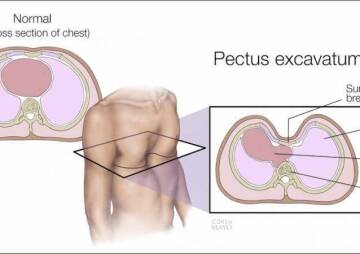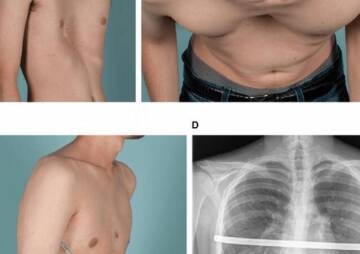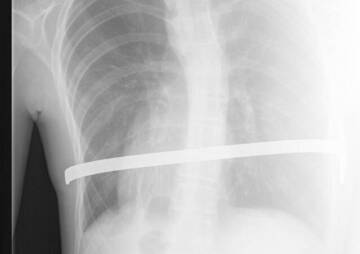-
Category
Craniomaxillofacial Surgery
Orthopedic Surgery
Spine Surgery
Orthopedic Implants
Hip Surgery
Knee Surgery
Pectus Excavatum
Bone Graft
Disinfectants
Healthcare
When does pectus excavatum require surgery?

Pectus excavatum is a disease that is related to the chest which is present from the day one when the person is born, and may develop further later as well. This condition also affects the lungs, and makes it hard for the individual to breathe.
In a pectus excavatum surgery the breastbone and the ribs are repaired and fixed, so that they stop squeezing and putting extra pressure on the heart and lungs because of the inward curve of the chest. When this condition occurs, the heart is pushed from the middle of the chest and is rotated to its left side, thus causing problem for it to pump blood into the veins. This condition also affects the lungs, and makes it hard for the individual to breathe.
Pectus excavatum is a disease that is related to the chest which is present from the day one when the person is born, and may develop further later as well. Pectus excavatum comes from a Latin word meaning hollowed chest. It causes the breastbone and the ribs to sunken inward or curve towards the inside. The other name for this condition is funnel chest. It is present at the time of birth but may get worse when the person is a teenager. This happens because the ribs and the breastbone start growing abnormally, thus causing this problem in the individual. Depending on the severity of the pectus excavatum, there are chances of the heart and the lungs facing problems too.
The pectus excavatum surgery can be performed in open and close manners. This operation, like many other operations, may cause discomfort and pain for the patient for few days after the surgery.
Pectus Excavatum Signs and Symptoms
The most common sign of pectus excavatum is the cup shaped concavity. People who are suffering from this condition may face back and chest pain too. Until today, researchers are unaware of the actual reason behind pectus excavatum, and they assume a genetic component must be causing it.
The surgery applied to correct the pectus excavatum is called the Nuss procedure. This process is named after Dr. D. Nuss, who used a tiny camera and thorascope to get a look at the inside of the patient’s chest during the process of the surgery. An important point is that the best age for the treatment through Nuss process is between 12 and 18 years.
Pectus Excavatum Surgery Process
In this process, the surgeon makes two small cuts on each side of the patient’s chest. Then, a tiny camera is inserted through a third cut to place the pectus bar into the chest. After this, the bar is pushed and placed accordingly. Once the bar is in the correct place, it is secured on the chest wall by the surgeon with a triangular fastener to avoid movement. The cuts are then closed with stitches under the skin and get dissolved on their own gradually. The total duration of the surgery is about 1 to 2 hours. After 2 to 4 years, the curve is expected to be corrected. This is when the pectus bars are removed from the patient’s body.
The process of Nuss is a new technique which does not require any bone or rib fracture. The steel which is used for giving shape to the ribs and breastbone have to remain in the body for approximately 2-4 years in order to have the proper effect and form the chest. With the process of open repair, the duration of the operation may be around 4 to 5 hours, whereas for Nuss it can be finished in about an hour.
Pectus Excavatum Surgery Risks
Just like any other surgery, there is the possibility of surgical complications with pectus excavatum as well.
Pneumothorax
This is a collapsed lung disease, which occurs when there is a leakage of air in the space between the lungs. It can be caused by a blunt and penetrating injury received in the chest, as well as certain medical procedures and damages which are causing lung diseases.
The common symptoms include chest pain and shortage of breath. In the treatment of pneumothorax a needle or a chest tube is inserted in the space between the ribs, in order to remove the excessive air which is causing pain. If the pneumothorax is not very big, it can heal on its own.
Bleeding
During the surgery, a needle is inserted inside the body, which increases the chance of bleeding. While bleeding is normal during the pectus excavatum surgery, unusual amounts of it may also occur. In this case, the surgeon will take the necessary steps to stop it.
Risk of death
Over the last 25 years, very few death cases have been reported in the literature of the medical injuries to the heart of the patient while the bar was being placed. But it’s not an impossible thing and death cases do happen.
Displacement of the bars
One of the major and most important things to remember during this surgery is to place the bars exactly at the right point and not to make mistakes. In case the bars are not placed in the right position, then not only the problem of pectus excavatum will not be solved but also the patient will feel uneasy and in pain. And if the bars are displaced after the surgery, then the patient needs to visit the surgeon as soon as possible and take a new x-ray to check the position of the bars.
The return of the condition
Pectus excavatum has chances of returning in both open and minimally invasive pectus excavatum repair, but the recurrence of the condition may among individuals vary based on the process which was carried out initially. It can return if the repair was done at a young age, the chest wall was not repaired completely, and/or the bars were removed earlier than necessary. All these cases can cause the pectus excavatum to return.
Pleural effusion
In this case, an amount of water is accumulated in the lungs. This water is in fact the excess of fluids built up between the pleural layers in the spaces outside of the lungs. The problem of pleural effusion is also caused as a result of pectus excavatum.
So far, we understood what pectus excavatum is, its causes and symptoms, and how it is fixed. In Health News Center we provide pectus bar used for this surgery. Have a look at them and learn more about what is used to fix pectus excavatum. Feel free to ask any questions regarding pectus excavatum, we are here to help you after all.


